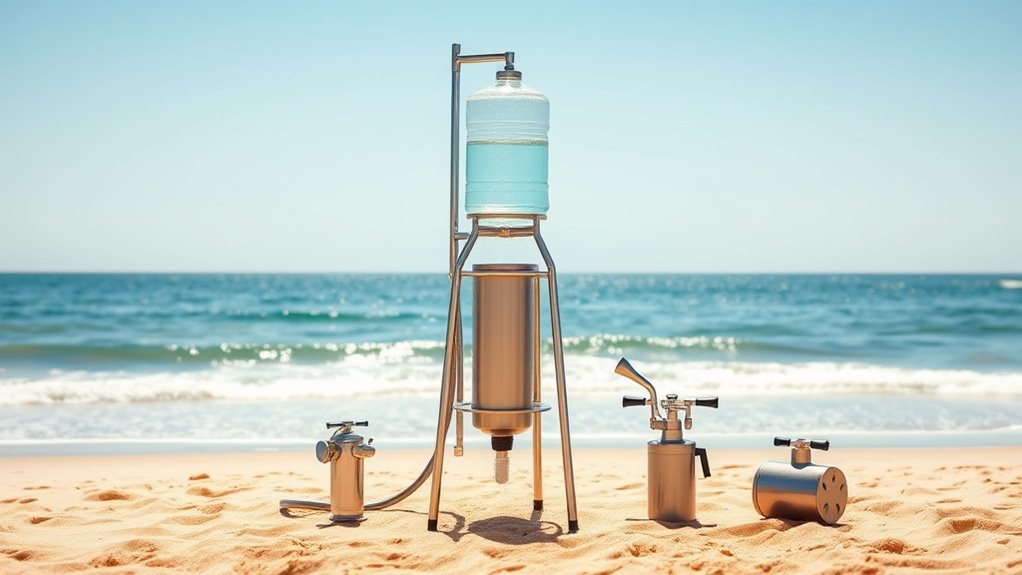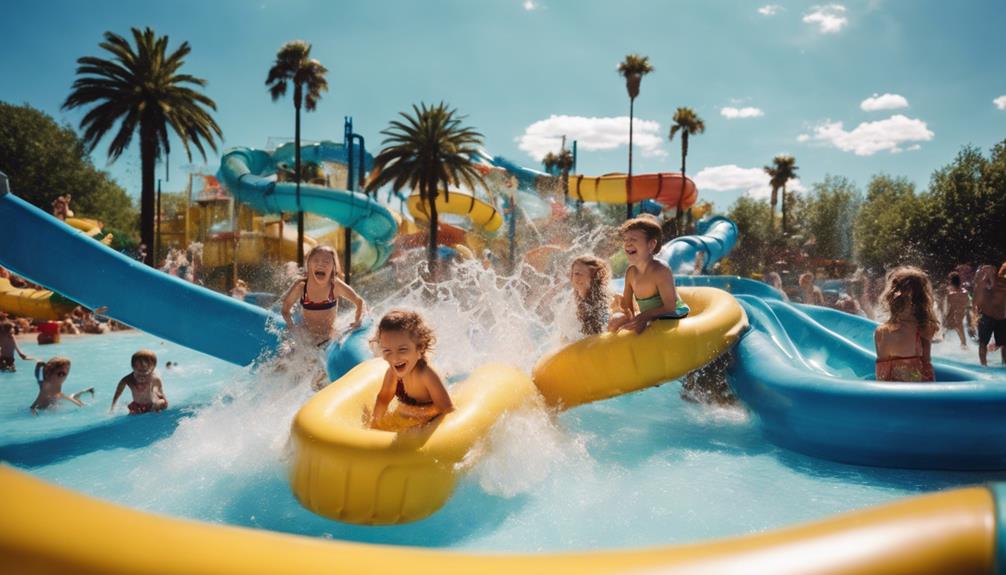Portable beach showers come in three main types: gravity-fed, pump-driven, and pressurized systems. Gravity showers rely on water height for flow, making them simple and eco-friendly but limited in pressure. Pump models use batteries or manual effort for more control and stronger streams, while pressurized units offer steady water flow with built-in air chambers for convenience. Keep exploring to discover how each option can suit your outdoor refreshment needs.
Key Takeaways
- Gravity-fed showers rely on elevated water containers, offering silent, eco-friendly operation without pumps or batteries.
- Pump-driven showers use rechargeable or battery-powered pumps for adjustable water pressure and flow control.
- Pressurized systems utilize pre-pressurized air chambers or CO2 cartridges for consistent water flow and pressure.
- Consider water capacity, setup ease, durability, and portability when choosing between gravity, pump, or pressurized options.
- Regular maintenance and proper material selection extend the lifespan and performance of each portable shower type.
Understanding Gravity-Fed Beach Showers
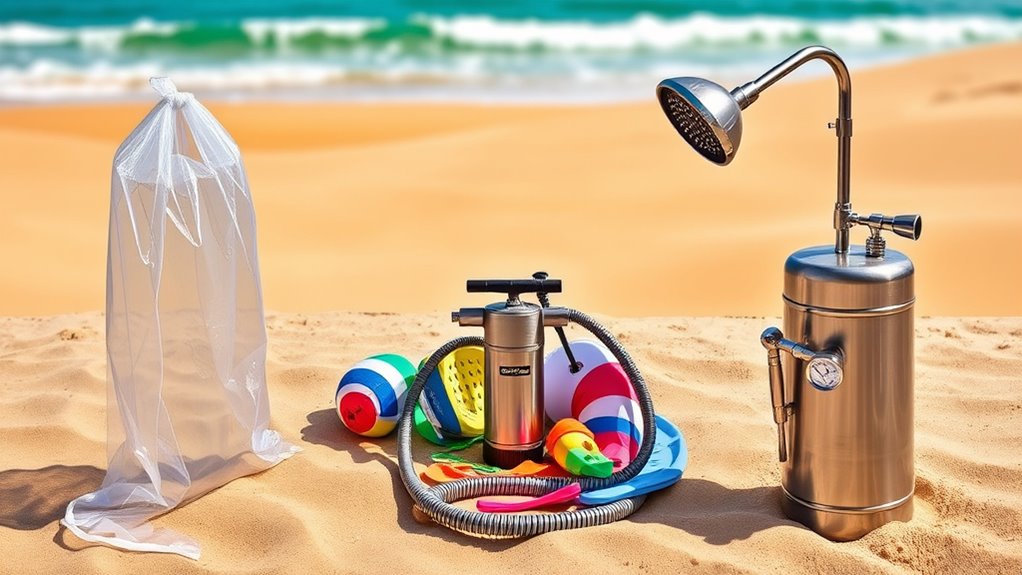
Gravity-fed beach showers rely on the natural force of gravity to supply water without the need for pumps or batteries. You elevate a water source, such as a reservoir or bag, above the showerhead, allowing gravity to create a steady flow of water. This setup is simple, portable, and environmentally friendly, making it ideal for beach outings. You fill the container with water, hang it at a height, and let gravity do the work. As water flows downward, it passes through a hose and out of the showerhead. The flow rate depends on the height of your water source and the container’s size. Gravity-fed showers are low-maintenance, silent, and reliable, perfect for quick rinses or invigorating after a swim. When choosing a setup, consider the cost and ease of installation to ensure it fits your needs and budget. Additionally, using portable water sources can enhance mobility and convenience during outdoor activities. The water pressure in gravity-fed systems is determined solely by the height of the water source, making it essential to select an appropriate elevation for desired flow. Using the right setup configuration can optimize performance and water flow efficiency during your outdoor shower experience.
How Pump-Driven Portable Showers Operate

Pump-driven portable showers operate by using a small, rechargeable or battery-powered pump to push water through the system. When you activate the pump, it creates pressure that moves water from your tank or reservoir through the showerhead. This setup allows you to enjoy a steady water flow without relying on gravity. The pressure generated by the pump can be adjusted to suit your preferences, providing control over water flow and pressure. You can control the water pressure and flow rate with a simple switch or valve. These showers are compact and easy to set up, making them ideal for camping, beach trips, or outdoor activities. Since the pump is powered by batteries, you don’t need an external power source, providing convenience and mobility. Regularly charging or replacing the batteries guarantees consistent performance for your outdoor shower needs. Expert advice can help you choose the right pump and setup for your specific needs. Additionally, selecting a powerful and reliable pump ensures optimal water flow and durability during outdoor use, especially considering the battery life of your pump. Proper maintenance and understanding of relationship dynamics can also enhance your overall outdoor experience.
Exploring Pressurized Shower Systems

Pressurized shower systems use different methods to deliver water at a consistent flow, making rinsing more efficient. You’ll find pump-driven models and pressurized systems that rely on tanks or compressed air, each with its own setup process. Understanding how water pressure works and how portable these systems are can help you choose the right option for your beach trips. Additionally, considering data privacy strategies can be beneficial if you or your family need extra reassurance during outdoor adventures. Some systems also incorporate pressure regulation features to ensure a steady water flow regardless of tank levels or external conditions. Implementing fraud detection techniques can help protect your personal information when purchasing portable systems online. Being aware of security concerns related to portable systems can help you select models that safeguard your data and privacy during use.
Water Pressure Mechanics
Understanding how water pressure works in portable beach showers is essential for ensuring a steady and comfortable flow. In pressurized systems, water pressure depends on how the container is sealed and pressurized. When you pressurize a tank, you’re increasing the force pushing water through the nozzle. This creates a consistent spray, even as the water level drops. To better grasp this, consider the table below:
| Pressure Source | How It Works | Key Benefit |
|---|---|---|
| Compressed Air | Air is pumped into tank | Maintains consistent flow |
| Built-in Pump | Hand or foot pump | Adjustable pressure |
| CO2 Cartridge | Gas cartridge release | Compact and portable |
| External Pump | External pump connection | Higher pressure options |
This understanding helps you choose the right system for your needs, ensuring a reliable shower experience. Proper maintenance of these systems can extend their lifespan and performance. Kia Tuning can also influence the efficiency of portable systems by optimizing engine and component performance to reduce overall energy consumption during outdoor activities. Additionally, knowing the pressure mechanics can assist in troubleshooting issues with water flow or pressure consistency.
Pump vs. Pressurized Systems
While both pump and pressurized systems aim to provide a steady water flow, they operate through fundamentally different mechanisms. Pump systems rely on manual effort or an electric pump to pressurize water from a reservoir, giving you control over water flow by pumping as needed. This setup often involves a small, portable pump that creates pressure directly in the hose or showerhead. Pressurized systems, on the other hand, use a built-in or external air chamber that’s pre-filled with air, which applies constant pressure to the water. When you turn on the shower, water flows steadily without additional effort. These systems are typically more convenient, offering consistent water flow with less manual work, making them ideal for quick, hassle-free showers at the beach. Additionally, the durability and quality of materials used in compact shower systems can significantly impact their longevity and performance. Choosing a system with high-quality materials ensures better durability and resistance to the elements, especially for outdoor use. Regular maintenance and proper cleaning of pressure chambers can help maintain consistent performance over time, and selecting models with robust construction can further enhance their lifespan. Moreover, selecting systems with corrosion-resistant components can be particularly beneficial for prolonged outdoor use.
Setup and Portability
Setting up a pressurized shower system is straightforward and designed for convenience. You’ll typically connect the water source to the system, then attach the showerhead. Most units are lightweight and compact, making them easy to transport and set up anywhere. With a pressurized system, you can enjoy consistent water flow without manual effort. Some models include quick-connect fittings for fast setup. To maximize portability, choose a unit with a durable carrying case or shoulder strap. Ensuring proper pressure regulation is essential for optimal performance and safety. Additionally, selecting a system with easy maintenance features can help keep it functioning smoothly during your outings. Incorporating tuning options can further customize the system for specific water pressure needs and enhance your overall experience. Regularly checking system compatibility ensures that all components work seamlessly together for reliable operation.
Key Features to Consider When Choosing a Shower
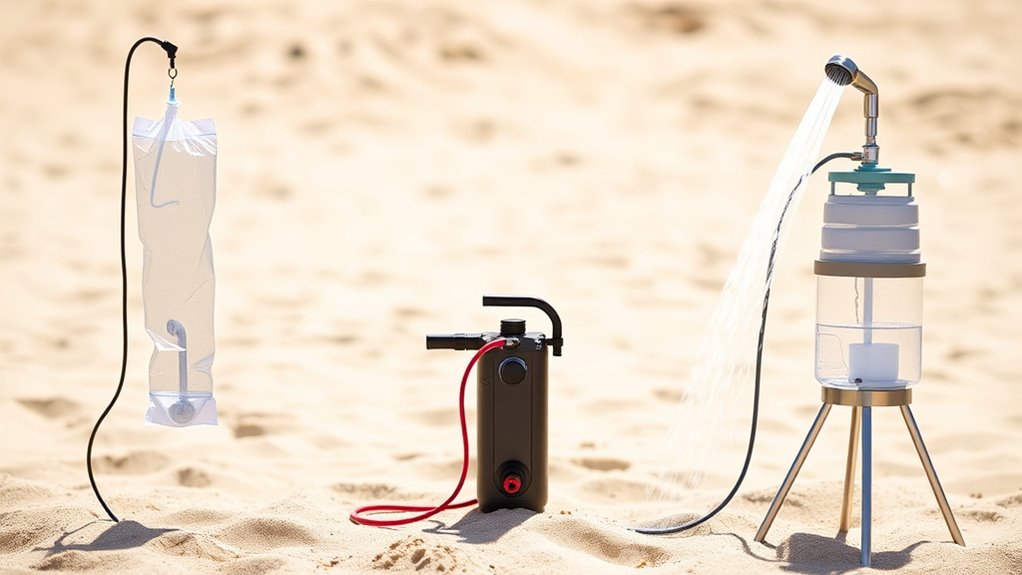
When selecting a portable beach shower, you need to think about water capacity and how long it will last during use. Ease of setup and operation are also vital to guarantee you can use it quickly and without hassle. Finally, consider the durability and quality of the materials to make certain your shower withstands outdoor conditions and frequent use.
Water Capacity and Duration
Water capacity and duration are crucial factors to contemplate because they determine how long you can enjoy a shower without needing a refill or recharge. If you plan extended beach visits, opt for a model with a larger tank or higher water capacity. This ensures you won’t run out of water halfway through your rinse. Consider how much water each shower session consumes; some units deliver a quick rinse, while others provide a more prolonged experience. Keep in mind that a higher capacity often means a heavier tank, which could affect portability. Balancing water capacity with your intended use helps you choose a shower that meets your needs without sacrificing convenience. Ultimately, selecting the right capacity ensures you stay clean and refreshed without constant refilling.
Ease of Setup and Use
Choosing a portable beach shower that’s easy to set up and operate can greatly enhance your outdoor experience. Look for models that require minimal assembly—quick-connect fittings or simple clips make setup faster. Consider whether the shower has clear instructions or intuitive controls, so you don’t spend extra time figuring it out. Pumps should be straightforward to operate, with user-friendly mechanisms that don’t require much effort. Pressurized systems with push-button controls are typically more convenient, while gravity-fed models often need less manual work. Check if the shower’s design allows for easy filling and draining without fuss. The more hassle-free it is to get your shower running, the sooner you can enjoy a invigorating rinse after a day at the beach.
Durability and Material Quality
Durability and material quality are essential factors that determine how well your portable beach shower will stand up to frequent use and the elements. High-quality materials like sturdy plastics, corrosion-resistant metals, and reinforced hoses ensure your shower lasts longer and performs reliably. Cheaper options may crack, leak, or degrade quickly, costing you more over time. Look for models with UV-resistant coatings and impact-resistant shells for added durability. The construction should feel solid, with secure fittings and reinforced seams. Consider the environment you’ll use it in—saltwater exposure demands corrosion-proof parts. Investing in a shower with proven durability means fewer replacements and better overall performance. Below is a quick comparison of common materials used in portable showers:
| Material | Durability & Suitability |
|---|---|
| High-Density Plastic | Lightweight, impact-resistant, UV-stable |
| Stainless Steel | Corrosion-resistant, long-lasting |
| Aluminum | Lightweight, corrosion-resistant, sturdy |
| Reinforced Vinyl | Flexible, resistant to tearing, weatherproof |
| Brass Fittings | Corrosion-proof, durable connection points |
Advantages and Limitations of Gravity-Fed Models
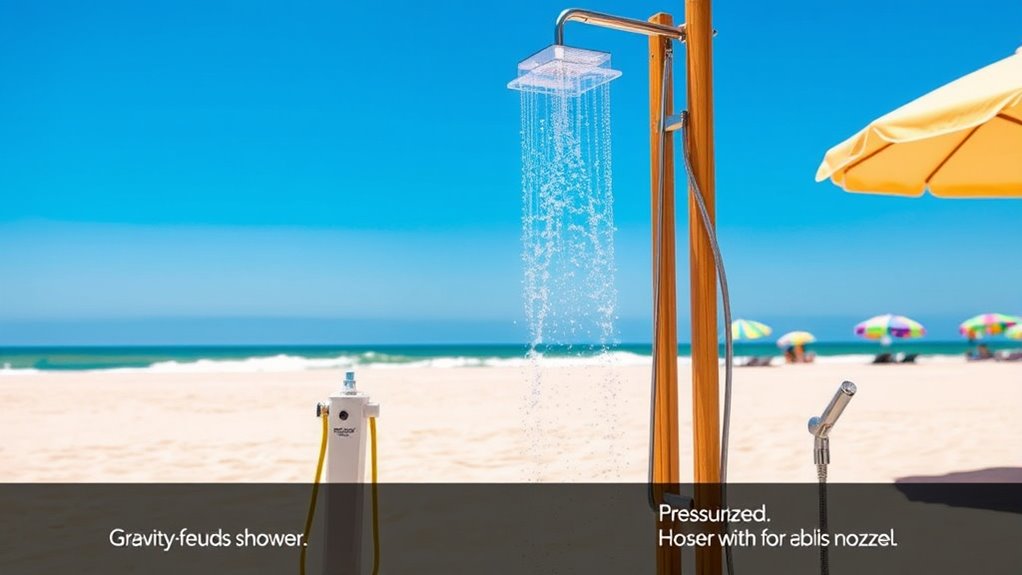
Gravity-fed models offer a simple and reliable way to supply water to portable beach showers without relying on pumps or electricity. Their main advantage is ease of use, as you just need to elevate the water source for consistent flow. However, they have limitations. You’re restricted by water height and pressure, which can reduce flow rate and shower comfort. They also require careful setup to ensure proper elevation and stability. Additionally, refilling can be inconvenient if the water source is distant or bulky. Ultimately, these models are less effective in uneven terrain or when quick access to water is needed.
Gravity-fed beach shower models are simple but limited by water height, pressure, and terrain.
- Limited water pressure due to gravity
- Dependence on proper elevation
- Difficult refilling in remote areas
- Reduced performance on uneven ground
Benefits and Drawbacks of Pump-Powered Units

Pump-powered units overcome many of the limitations inherent in gravity-fed systems by actively boosting water pressure. This means you’ll enjoy a more consistent and powerful stream, making rinsing off sand and salt much easier. They’re especially useful when water sources are low or uneven, as the pump can draw water from various containers or wells. However, these units require batteries or manual effort, which can add weight and complexity. They also tend to be more expensive than gravity models and may need regular maintenance to keep the pump functioning smoothly. Additionally, if the battery runs out or the pump malfunctions, your shower performance drops considerably. Overall, pump-powered units give you better pressure and flexibility but at the cost of added weight, maintenance, and expense.
The Convenience of Pressurized Shower Setups
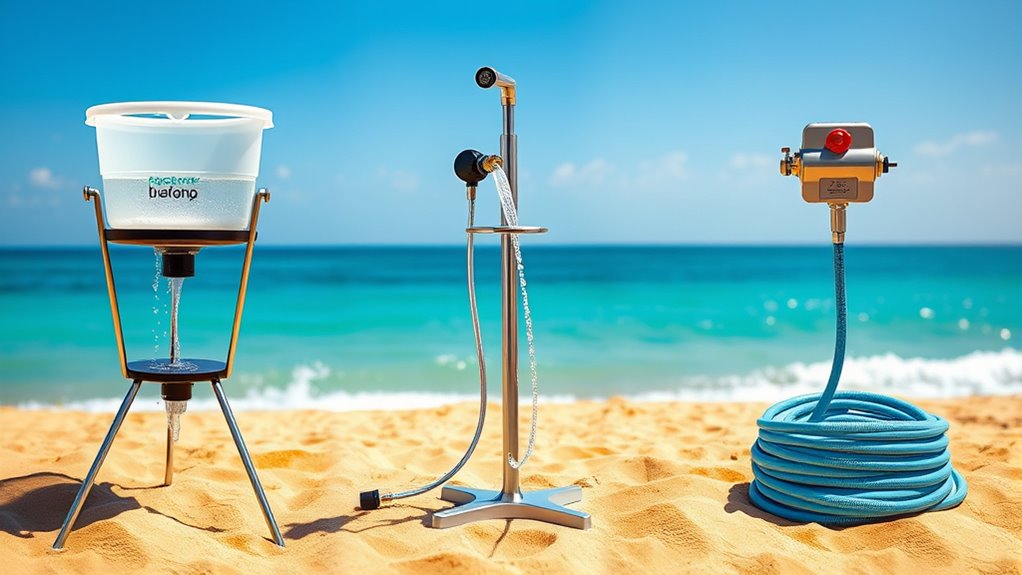
Pressurized shower setups offer a level of convenience that makes outdoor rinsing quick and effortless. With pressurized systems, you get consistent water flow without manual effort, so you can rinse off thoroughly in less time. They’re ideal for beach trips, camping, or outdoor events where quick cleanup matters. You’ll appreciate features like:
- Adjustable water pressure for personalized comfort
- Easy connection to standard water sources
- Reliable spray patterns for different rinsing needs
- Minimal setup, often just attaching to a water container or source
This setup ensures you don’t waste time dealing with inconsistent flow or manual pumping. Instead, you enjoy a steady, controlled stream of water that makes outdoor cleansing straightforward and efficient.
Tips for Maintaining and Using Your Portable Shower
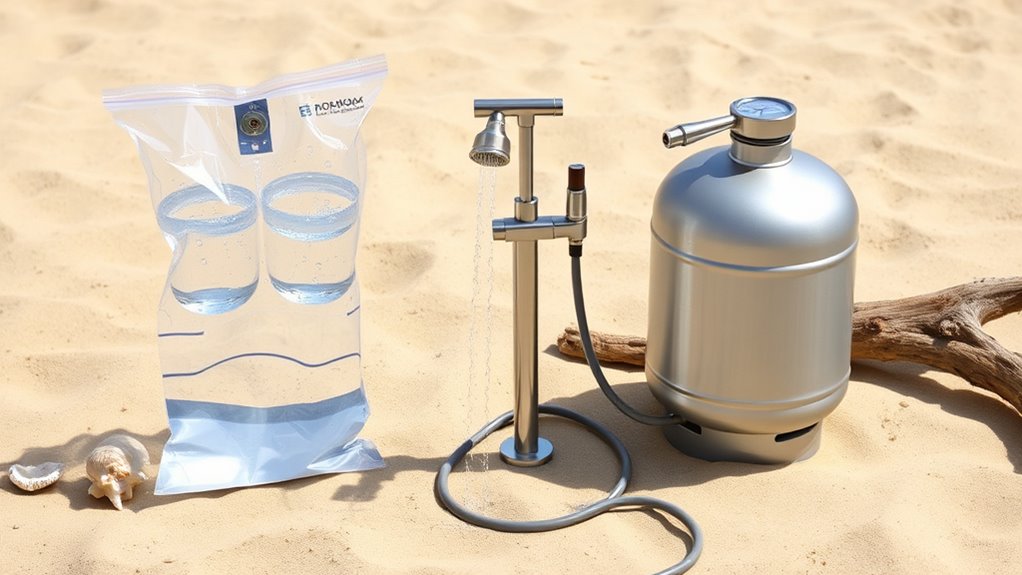
To keep your portable shower functioning smoothly, regular maintenance and proper usage are essential. Always rinse the tank and hoses after each use to prevent mold and buildup. Check for leaks or cracks, and tighten fittings as needed. When storing, ensure the unit is dry and stored in a cool, shaded area to prevent damage. Use the shower on a stable surface to avoid spills or accidents. When filling the tank, avoid overfilling to prevent leaks or pressure issues. Follow the manufacturer’s instructions for pump or pressurized systems to avoid damage. Periodically inspect seals and valves, replacing worn parts promptly. Properly maintaining your shower guarantees reliable performance, extends its lifespan, and keeps your outdoor showers hygienic and ready whenever you need them.
Frequently Asked Questions
What Is the Typical Water Capacity for Portable Beach Showers?
You’re wondering about the typical water capacity for portable beach showers. Generally, these showers hold between 2 to 5 gallons, enough for multiple rinses without being too heavy to carry. Smaller models are around 1.5 gallons, perfect for quick washes, while larger ones can reach 5 gallons, providing more water for extended use. Your choice depends on how long you need the shower and portability needs.
How Long Can a Gravity-Fed Shower Supply Water Before Refilling?
Think of your gravity-fed shower as a delicate balance beam—you’re only as strong as your water supply. Typically, it can provide around 2 to 5 gallons, which lasts approximately 10 to 20 minutes of steady use. Your experience depends on water pressure and flow rate. To avoid running dry mid-shower, plan your rinsing and soap time wisely, and keep an eye on your water level.
Are There Eco-Friendly Options for Portable Beach Showers?
Yes, there are eco-friendly options for portable beach showers. You can choose solar-powered showers that use sunlight to heat water, reducing energy consumption. Another option is using biodegradable soaps and refillable water containers to minimize waste. Additionally, some showers feature rechargeable batteries or manual pumps, so you don’t rely on electricity. By selecting these sustainable choices, you help protect the environment while enjoying your beach experience.
Can Portable Showers Be Used With Saltwater or Chlorinated Water?
You wonder if portable showers work with saltwater or chlorinated water. Yes, they do, but with some caution. Saltwater can cause corrosion, so you should rinse your shower components afterward. Chlorinated water is less harmful but still may affect seals and materials over time. To keep your shower in good shape, regularly clean and maintain it, and consider using freshwater rinses after saltwater use.
What Safety Precautions Should Be Taken When Using Pressurized Shower Systems?
When using pressurized shower systems, you should always check for leaks and guarantee all connections are secure before use. Wear protective gear like goggles and gloves to prevent injury from high-pressure water. Avoid aiming the spray at your face or others, and never modify or over-pressurize the system. Regularly inspect the equipment for damage, and follow the manufacturer’s instructions to maintain safety.
Conclusion
Imagine you’re at the beach, ready to rinse off after a swim. Choosing the right portable shower—whether gravity-fed, pump-driven, or pressurized—can make all the difference. For example, a solo traveler might prefer a lightweight gravity model for simplicity, while a family could benefit from a pressurized system for quick rinses. Whatever your needs, understanding these options helps you stay comfortable and refreshed during your beach adventures.

